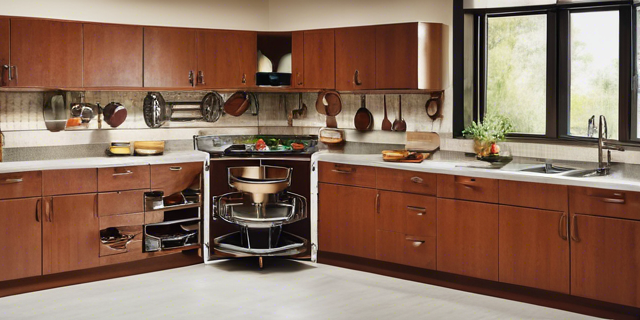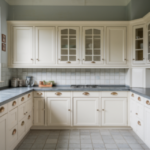Introduction
When it comes to maximizing space in your kitchen, corner base cabinets are the unsung heroes. These nifty storage solutions can transform awkward, unused corners into functional, organized spaces. In this article, we’ll dive deep into the world of corner base cabinets, exploring their types, benefits, installation tips, and more. Whether you’re renovating your kitchen or just curious about these unique cabinets, we’ve got you covered.
What is a Corner Base Cabinet?
Definition and Purpose
A corner base cabinet is a storage unit designed to fit into the corner of a kitchen, utilizing space that often goes unused. These cabinets are typically located at the junction of two perpendicular walls and are engineered to provide both storage and accessibility in these tricky spots.
Common Uses in Kitchen Design
Corner base cabinets are most commonly used in kitchen layouts to store pots, pans, and other bulky items that need a bit more space. They’re also perfect for stashing away less frequently used appliances, keeping your kitchen countertops clutter-free.
Types of Corner Base Cabinets
Lazy Susan Cabinets
Lazy Susan cabinets are the quintessential corner cabinet solution. These cabinets feature rotating shelves that make it easy to access items stored in the back. They’re ideal for storing canned goods, spices, and other small items that can get lost in deeper cabinets.

Blind Corner Cabinets
Blind corner cabinets are designed with one part of the cabinet hidden behind another, making it a bit challenging to access. However, with the addition of pull-out shelves or swing-out mechanisms, these cabinets can become highly functional storage spaces.

Diagonal Corner Cabinets
Diagonal corner cabinets have a unique design that cuts across the corner, creating a more accessible and spacious cabinet. This design is often used for aesthetic reasons, providing a seamless look in modern kitchen designs.

Pros and Cons of Corner Base Cabinets
Advantages
The primary advantage of corner base cabinets is their ability to utilize space that would otherwise be wasted. They also help in maintaining a clean and organized kitchen by providing ample storage for various items. Additionally, corner cabinets can enhance the overall look of your kitchen by providing a more polished and custom appearance.
Disadvantages
On the downside, corner base cabinets can be tricky to install and may require custom solutions or professional help. They can also be more expensive than standard cabinets due to their specialized design. Moreover, some designs, like blind corner cabinets, may not be as accessible as other storage solutions.
Materials and Finishes
Wood Options
Wood is the most popular material for corner base cabinets, offering durability and a classic look. Common wood choices include oak, maple, cherry, and hickory, each providing a unique grain pattern and color.
Alternative Materials
Beyond wood, corner base cabinets can be made from materials like laminate, stainless steel, and thermofoil. These alternatives offer varying levels of durability, maintenance, and aesthetic appeal.
Popular Finishes
When it comes to finishes, you have a plethora of options, from stained wood that highlights natural grain to painted finishes in a variety of colors. Glazed finishes add an antique look, while distressed finishes give a rustic charm.
How to Choose the Right Corner Base Cabinet
Kitchen Layout Considerations
Choosing the right corner base cabinet starts with understanding your kitchen layout. Consider the flow of your kitchen and how a corner cabinet can complement your design. Ensure there’s enough space for the cabinet doors to open fully without obstruction.
Storage Needs and Functionality
Think about what you plan to store in your corner base cabinet. If you need to store heavy pots and pans, a sturdy Lazy Susan might be your best bet. For smaller items, pull-out trays or shelving can provide easy access and organization.
Installation Tips
Measuring Your Space
Accurate measurements are crucial for installing a corner base cabinet. Measure the dimensions of the corner space carefully, including the height, width, and depth. Don’t forget to account for any plumbing or electrical work that might be in the way.
Assembling the Cabinet
Follow the manufacturer’s instructions meticulously when assembling your corner base cabinet. If you’re not confident in your DIY skills, consider hiring a professional to ensure everything is put together correctly.
Securing the Cabinet Properly
Once assembled, the cabinet needs to be secured to the walls and floor. Use appropriate brackets and screws to ensure the cabinet is stable and can handle the weight of stored items. Double-check for levelness to avoid any tilting issues.
Maximizing Storage in Corner Base Cabinets
Utilizing Inserts and Organizers
Inserts and organizers are game-changers for corner base cabinets. Lazy Susans, pull-out trays, and tiered shelves can transform your cabinet into a highly efficient storage space. Custom inserts can be designed to fit specific items, making the most of every inch.
DIY Solutions
If you’re a DIY enthusiast, you can create your own organizers using inexpensive materials. Consider adding pegboards, hooks, or custom shelving to adapt the cabinet to your specific needs. This not only saves money but also adds a personal touch to your kitchen.
Maintenance and Care
Cleaning Tips
Regular cleaning keeps your corner base cabinet looking great and functioning well. Use a gentle cleaner and a soft cloth to wipe down the surfaces. Avoid harsh chemicals that can damage the finish or material.
Preventing Wear and Tear
To prevent wear and tear, consider lining the shelves with protective mats and avoiding overloading the cabinet. Regularly check for loose screws or hinges and tighten them as needed to maintain stability.
Cost Factors
The cost of corner base cabinets varies depending on factors such as material, size, and additional features. On average, expect to allocate a significant portion of your kitchen renovation budget to these cabinets, as they are pivotal in optimizing storage space.
Comparison with Other Cabinet Options
Compared to traditional base or wall cabinets, corner base cabinets excel in maximizing corner space efficiency. They provide deeper storage options and are essential for storing larger items that may not fit in standard cabinets or shelves.
Customer Reviews and Feedback
Feedback from homeowners who have installed corner base cabinets often highlights their effectiveness in transforming kitchen storage. Many users appreciate the convenience and accessibility these cabinets offer, making everyday kitchen tasks more manageable.
Innovations in Corner Base Cabinet Design
Recent advancements in corner base cabinet design focus on sustainability and user-friendly features. Manufacturers are increasingly using eco-friendly materials and incorporating smart storage solutions to cater to modern kitchen trends.
FAQs
What is the standard size of a corner base cabinet?
Corner base cabinets typically come in sizes ranging from 36 inches to 48 inches wide, with a standard depth of 24 inches.
How do lazy Susans work in corner cabinets?
Lazy Susans feature rotating circular shelves that allow you to access items stored in the back by simply rotating the shelves.
Can I customize a corner base cabinet to fit my kitchen layout?
Yes, many manufacturers offer customization options for corner base cabinets to fit specific kitchen layouts and design preferences.
What is the weight capacity of a typical corner base cabinet shelf?
The weight capacity varies depending on the construction and materials used, but most shelves can support up to 50-100 pounds of evenly distributed weight.
Are corner base cabinets more expensive than standard base cabinets?
Yes, corner base cabinets tend to be slightly more expensive due to their specialized design and additional features for maximizing corner space.
Conclusion
In conclusion, investing in corner base cabinets is a strategic decision that enhances both the functionality and aesthetics of your kitchen. By carefully considering your kitchen layout, storage needs, and budget, you can select corner base cabinets that not only optimize space but also complement your lifestyle.








